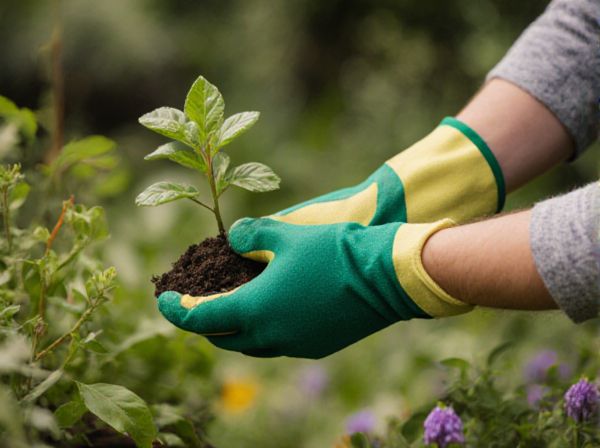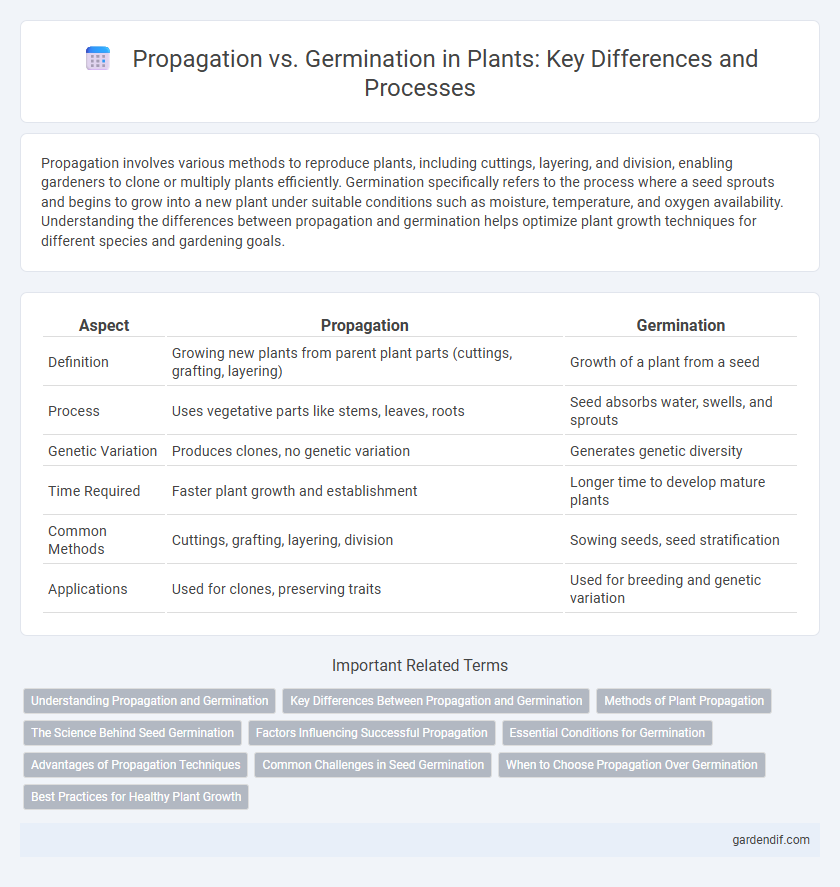
Propagation vs Germination Illustration
Propagation involves various methods to reproduce plants, including cuttings, layering, and division, enabling gardeners to clone or multiply plants efficiently. Germination specifically refers to the process where a seed sprouts and begins to grow into a new plant under suitable conditions such as moisture, temperature, and oxygen availability. Understanding the differences between propagation and germination helps optimize plant growth techniques for different species and gardening goals.
Table of Comparison
| Aspect | Propagation | Germination |
|---|---|---|
| Definition | Growing new plants from parent plant parts (cuttings, grafting, layering) | Growth of a plant from a seed |
| Process | Uses vegetative parts like stems, leaves, roots | Seed absorbs water, swells, and sprouts |
| Genetic Variation | Produces clones, no genetic variation | Generates genetic diversity |
| Time Required | Faster plant growth and establishment | Longer time to develop mature plants |
| Common Methods | Cuttings, grafting, layering, division | Sowing seeds, seed stratification |
| Applications | Used for clones, preserving traits | Used for breeding and genetic variation |
Understanding Propagation and Germination
Propagation and germination are essential processes in plant reproduction and growth, with propagation involving the creation of new plants from various parts such as stems, leaves, or roots, while germination refers specifically to the development of a plant from a seed. Propagation enables rapid multiplication and preservation of plant traits through methods like cuttings, layering, or grafting, whereas germination marks the initial growth phase where a seed sprouts and roots, shoots, and leaves begin to form. Both processes are critical for horticulture, agriculture, and ecosystem sustainability, influencing plant diversification and crop production efficiency.
Key Differences Between Propagation and Germination
Propagation involves creating new plants through various methods such as cuttings, grafting, or division, enabling cloning of the parent plant with identical genetic material. Germination specifically refers to the process by which a seed develops into a new plant, marked by the emergence of the radicle and shoot under suitable environmental conditions. Key differences include propagation's use of vegetative parts versus germination's reliance on seeds, and propagation's capability for rapid multiplication compared to the longer timeframe needed for seed germination.
Methods of Plant Propagation
Plant propagation involves various methods such as cuttings, layering, division, grafting, and tissue culture, enabling the production of new plants from parts of existing ones. Germination specifically refers to the process where seeds develop into seedlings under favorable conditions of moisture, temperature, and oxygen. Vegetative propagation methods like cuttings and grafting bypass seed germination, facilitating faster and genetically identical plant multiplication.
The Science Behind Seed Germination
Seed germination involves the activation of metabolic pathways within a seed, turning stored nutrients into energy to support embryonic growth. Key environmental factors such as moisture, temperature, oxygen, and light trigger enzymatic activities that break down starches into sugars, fueling cell division and elongation. Unlike propagation methods like cuttings or layering, germination relies on the intrinsic biological processes encoded within the seed to develop into a healthy plant.
Factors Influencing Successful Propagation
Successful propagation depends on factors such as optimal temperature, moisture levels, and light exposure, which vary between species. Proper medium aeration and nutrient availability are crucial for root development in vegetative propagation methods like cuttings and grafting. Disease control and the use of healthy parent plants also significantly improve propagation outcomes compared to seed germination processes.
Essential Conditions for Germination
Germination requires essential conditions such as optimal temperature, sufficient moisture, and oxygen to activate the seed's metabolic processes. Light sensitivity varies among species, with some seeds germinating in darkness while others require exposure to light. Proper soil conditions, including pH balance and nutrient availability, also play a critical role in successful germination.
Advantages of Propagation Techniques
Propagation techniques offer faster plant reproduction compared to germination, allowing gardeners to clone desirable traits and ensure uniformity in crops. These methods provide higher survival rates by bypassing the vulnerable seedling stage and reducing exposure to environmental stressors. Additionally, propagation enables year-round plant production and the ability to perpetuate seedless or hybrid varieties that cannot reproduce through seeds.
Common Challenges in Seed Germination
Common challenges in seed germination include improper moisture levels, temperature fluctuations, and inadequate oxygen availability, which can all hinder successful sprouting. Seed dormancy and fungal infections also pose significant obstacles, often requiring specific pre-treatment methods like stratification or scarification to overcome. Understanding these factors is crucial for optimizing germination rates in various plant species.
When to Choose Propagation Over Germination
Propagation is preferred over germination when rapid multiplication of plants with identical characteristics is needed, such as in fruit trees or ornamental plants that do not breed true from seed. While germination relies on seeds developing into new plants, propagation techniques like cuttings, grafting, or division enable growers to bypass genetic variability and accelerate growth cycles. Propagation is ideal for preserving specific traits, ensuring uniformity, and producing mature plants faster than waiting for seed germination and seedling development.
Best Practices for Healthy Plant Growth
Propagation involves creating new plants from cuttings, divisions, or grafting, ensuring genetic consistency and faster maturation, while germination is the process where seeds sprout under optimal conditions of moisture, temperature, and light. Best practices for healthy plant growth emphasize sterilized tools during propagation, consistent soil moisture, and proper temperature control to avoid fungal diseases or seed rot. Employing high-quality sowing mediums and regularly monitoring humidity levels accelerates germination success and ensures robust seedling development.
Propagation vs Germination Infographic

 gardendif.com
gardendif.com